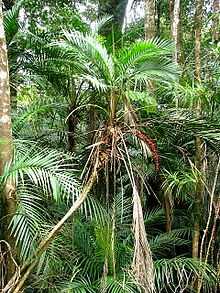Laccospadix
| Atherton palm Queensland kentia | |
|---|---|
 | |
| Laccospadix australasicus, Herberton Range | |
| Scientific classification | |
| Kingdom: | Plantae |
| (unranked): | Angiosperms |
| (unranked): | Monocots |
| (unranked): | Commelinids |
| Order: | Arecales |
| Family: | Arecaceae |
| Subfamily: | Arecoideae |
| Tribe: | Areceae |
| Genus: | Laccospadix H.Wendl. & Drude[1] |
| Species: | L. australasicus |
| Binomial name | |
| Laccospadix australasicus H.Wendl. & Drude | |
| Synonyms[2] | |
| |
Laccospadix is a monotypic genus of flowering plant in the palm endemic to Queensland.[2] Only one species is known, Laccospadix australasicus, commonly called Atherton palm or Queensland kentia. The two Greek words from which it is named translate to "reservoir" and "spadix".
Description
Laccospadix australasicus may be solitary or clustering, in the former the trunks will grow to around 10 cm in width while clustering plants are closer to 5 cm wide. The trunks may be dark green to almost black at the base, lightening with age, and conspicuously ringed by leaf scars. Lone trunks will reach 7 m in height while the suckering varieties grow to 3.5 m. The leaves are pinnate, emerging erect with a slight arch, to 2 m on 1 m or less petioles; the petioles and rachises are usually covered in scales. The new foliage is often red to bronze, a feature more common in solitary individuals.[3]
The inflorescence is a long, unbranched spike, emerging within the leaf crown, to a meter long, carrying male and female flowers, both with three sepals and three longer petals. Laccospadix fruit is slightly ovoid, one-seeded and bright red, with a smooth epicarp and a thin fleshy mesocarp.[4]
Distribution and habitat
Found in Queensland, Australia at elevations of 800–1400 m in humid rain forest, they grow on mountains and plateau where they receive little light.
References
- ↑ H. A. Wendland and Drude Nachrichten von der Georg-Agustus-Universität 1875:59. 1875. Type: L. australasica
- ↑ 2.0 2.1 Kew World Checklist of Selected Plant Families
- ↑ Riffle, Robert L. and Craft, Paul (2003) An Encyclopedia of Cultivated Palms. Portland: Timber Press. ISBN 0-88192-558-6 / ISBN 978-0-88192-558-6
- ↑ Uhl, Natalie W. and Dransfield, John (1987) Genera Palmarum - A classification of palms based on the work of Harold E. Moore. Lawrence, Kansas: Allen Press. ISBN 0-935868-30-5 / ISBN 978-0-935868-30-2
External links
 Media related to Laccospadix australasicus at Wikimedia Commons
Media related to Laccospadix australasicus at Wikimedia Commons- Laccospadix on NPGS/GRIN
- Fairchild Guide to Palms: Laccospadix
- GBIF portal
- Plantsystematics.org with images
- Photos at PACSOA